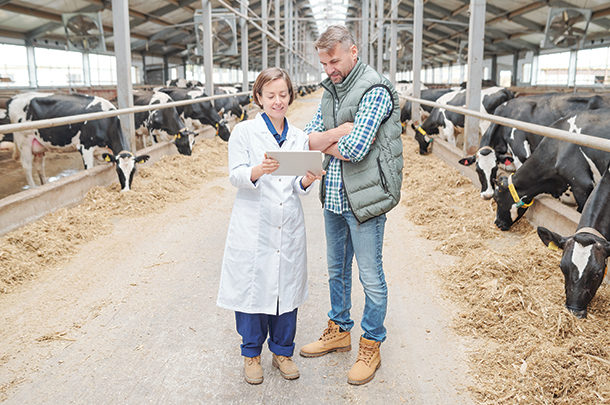Researchers are developing a surveillance program to measure antimicrobial use (AMU) and antimicrobial resistance (AMR) on Canadian dairy farms, as well as the effectiveness of antimicrobial stewardship protocols and programs. Led by researchers Javier Sanchez and Luke Heider at the University of Prince Edward Island with collaborators from across Canada, the team is collecting data and information to help support farmers’ efforts in applying effective antimicrobial stewardship practices.
The pan-Canadian team has developed a platform to collect data and monitor AMU and AMR. The Canadian Dairy Network of Antimicrobial Stewardship and Resistance (CaDNetASR) is a first for the dairy sector and designed to conform with the Federal Action Plan on Antimicrobial Resistance and Use in Canada, and the Food Safety and Biosecurity modules of proAction. Data is being collected on about 150 dairy farms in British Columbia, Alberta, Ontario, Quebec, Nova Scotia and New Brunswick on a yearly basis.
To provide antimicrobial use data estimates, treatment records logged as part of the Food Safety and Biosecurity modules of proAction and the retrieval of receptacles placed on farms for the deposit of empty drug bottles and containers are being used. To measure antimicrobial resistance on dairy farms, fecal, environmental and bulk tank milk samples are being taken and analyzed. The information will serve as a base for the development and testing of evidence-based and effective tools for farmers and their veterinarians (i.e., standard operating protocols or SOPs).
The project outcomes will support farmers in continuing to use antimicrobials responsibly, apply efficient antimicrobial stewardship practices and ensure the continued health and welfare of dairy animals and the safety of food for consumers.
Seven facts about antibiotic use and antimicrobial resistance in the Canadian dairy sector
- Under proAction, milk is produced according to strict provincial and federal regulations and high standards regarding antibiotic use to treat sick animals. proAction milk quality and food safety standards are among the highest in the world.
- Dairy farmers use antibiotics to treat sick animals if necessary and as directed on the prescribed medication label and directives given by the herd’s veterinarian.
- Canadian milk is free of antibiotics. Cows treated with antibiotics for a medical reason are clearly identified, and the milk is discarded. The milk does not re-enter the system until the mandatory withdrawal time has been met to ensure the medication is out of the animal’s system.
- Milk picked up at the farm is sampled and inspected for quality standards by an expert before it is loaded onto the truck. The milk is tested for antibiotics at processing plants and labs to ensure it meets quality and food safety standards. Some farmers test every tank before offering the milk for sale or may test treated cows as an added assurance their milk is clear to go in the bulk tank.
- Antibiotic resistance happens when bacteria change and become resistant to the antibiotics used to treat the infections they cause.
- Antimicrobial resistance development in major pathogenic bacteria found in dairy cows does not yet appear to be a major problem in North America. Most antibiotic treatments are to treat mastitis, and the levels of antimicrobial resistance remain low in mastitis pathogens. But the pressures to select and use antimicrobials to treat animals more rapidly for better health can result in the emergence and transfer of bacteria that are resistant.
- Disease prevention is key in a strategy to reduce antimicrobial use and resistance.
Access the project summary by finding this article on Dairy Research Blog.
References omitted but are available upon request. Click here to email an editor.
Project overview
Principal investigators: Javier Sanchez and Luke Heider, University of Prince Edward Island
Co-investigators: J Trenton McClure, Greg Keefe, University of Prince Edward Island; David Leger, Public Health Agency of Canada; Simon Dufour, Université de Montréal; Herman Barkema, University of Calgary; David Kelton, University of Guelph; Christopher Luby, University of Saskatchewan; and Kapil Tahlan, Memorial University of Newfoundland
Collaborators: Marie Archambault, David Francoz, André Ravel, Jean-Phillipe Roy, Université de Montréal; Jeroen De Buck, University of Calgary; Scott McEwen, Jan Sargeant, Scott Weese, University of Guelph; Cheryl Waldner, University of Saskatchewan; Richard Reid Smith, Public Health Agency of Canada
Project duration: 2018-22
Project partners: Agriculture and Agri-Food Canada, Dairy Farmers of Canada and the Public Health Agency of Canada
Total budget: $1,582,087
Canadian Dairy Research: For a profitable, innovative and sustainable sector
Dairy Farmers of Canada (DFC) invests in research to stimulate productivity, sustainability and profitability on farms and to improve knowledge on milk and dairy products’ health benefits. DFC finances research initiatives that benefit all dairy farmers across Canada and works in collaboration with its members and other sectorial partners to address farmers’ priorities set in the dairy research and knowledge translation, and transfer national strategies. Visit dairyresearch.ca for more information.









